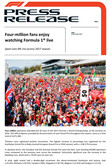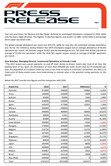 Formula One has done a spectacular U-Turn on its much-trumpeted attendance data after it admitted that it contained a "systematic error" according to a report for the BBC by Christian Sylt.
Formula One has done a spectacular U-Turn on its much-trumpeted attendance data after it admitted that it contained a "systematic error" according to a report for the BBC by Christian Sylt.
The press release about the data was distributed to selected media outlets two weeks ago and boasted that attendance at F1 races this year saw "an 8% increase on 2016". Not only was this inaccurate but there was an error in 19 of the 21 percentages which the figure was derived from. Worse still, many of the attendance figures contradict the data from the race organisers themselves with their year-on-year increases being up to four times lower than those released by F1.
It is especially embarrassing for F1 as it is listed on America's Nasdaq stock exchange and its managing director of commercial operations, Sean Bratches, is quoted in the release. It was distributed to selected media outlets all over the world including Reuters, NBC, Fox Sports and Racer, who all faithfully published the data, not one of them noticing that it was riddled with basic errors.
A cursory look through the F1 press release reveals that the percentage increases have not been calculated correctly. For example, attendance at the Austrian Grand Prix is said to have accelerated by 41%, from 85,000 in 2016 to 145,000 this year even though this is actually a 71% rise. Likewise, F1 claimed that the Italian Grand Prix attracted 20.3% more spectators in 2017 as its attendance rose from 147,500 to 185,000 which is actually an increase of 25.4%.
The most significant error however is with the Azerbaijan Grand Prix which took place on the streets of the country's capital Baku in June. According to F1 it was watched by 71,451 spectators compared to 30,000 the previous year which is actually an increase of 138.2% not 58% as the press release claims.
 A spokesperson for F1 told the BBC that "there was a systematic error in the percentage calculation" and sent it an updated version of the press release containing the correct percentages. It isn't clear if the updated release was distributed more widely as it has not been reported by other media outlets. The BBC report referred to it but didn't publish the updated release which can be seen for the first time along with the original and amended data (right).
A spokesperson for F1 told the BBC that "there was a systematic error in the percentage calculation" and sent it an updated version of the press release containing the correct percentages. It isn't clear if the updated release was distributed more widely as it has not been reported by other media outlets. The BBC report referred to it but didn't publish the updated release which can be seen for the first time along with the original and amended data (right).
Although the updated release is now mathematically accurate it isn't clear whether it is factually accurate. This is because the data in it doesn't just still contradict publicly-available numbers from many of the race organisers but this discrepancy is now even more stark.
The most marked contradiction is again with the attendance at the Azerbaijan Grand Prix which increased by 138.2% on 2016 according to F1's updated release. However, following this year's race the organisers, Baku City Circuit, released a statement saying that 71,541 spectators were in attendance which "represents a 30% increase in ticket sales from the inaugural 2016 event". This puts last year's total at 55,032 but both F1's original and updated releases claim that there were actually only 30,000 spectators there.
F1's press releases state that the figures were "provided by the promoters of each Grand Prix throughout the season" so if it is right about the 30,000 attendance in 2016 it would suggest that the race organiser had inflated the figure to 55,032. Alternatively, if Baku City Circuit's figure of 55,032 is accurate, the consequence of F1 using an attendance figure which is 25,000 lower is that it inflated the year-on-year increase.
It could put F1 on a collision course with the organisers of the Azerbaijan Grand Prix and it wouldn't be the first time. In March Greg Maffei, chief executive of F1's owner Liberty Media, accused Azerbaijan of buying it's way on to the calendar.
 Liberty bought F1 from the private equity firm CVC for $8bn in January but the contract with Azerbaijan was signed by the sport's former management which was led by Bernie Ecclestone. Maffei claimed that the driving force behind Ecclestone signing new races was: "How much can I extract? How much upfront? So we end up with races in places like Baku in Azerbaijan where they paid us a big race fee but it does nothing to build the long-term brand and health of the business. Our job is to find partners that pay us well but also help us to build the product."
Liberty bought F1 from the private equity firm CVC for $8bn in January but the contract with Azerbaijan was signed by the sport's former management which was led by Bernie Ecclestone. Maffei claimed that the driving force behind Ecclestone signing new races was: "How much can I extract? How much upfront? So we end up with races in places like Baku in Azerbaijan where they paid us a big race fee but it does nothing to build the long-term brand and health of the business. Our job is to find partners that pay us well but also help us to build the product."
Referring to the contradiction with the data from the race organisers, F1's spokesperson simply said "this is what we have received from the promoters." Interestingly, it isn't only the data for 2016 that doesn't match the figures from the race organisers but 2017 as well in many cases.
F1's attendance total of 71,451 for the 2017 Azerbaijan Grand Prix is slightly different to the 71,541 that Baku City Circuit said were at the race. Similarly, the organisers of the Abu Dhabi Grand Prix say that attendance at this year's event came to around 145,000 but F1 claims that it was 195,000. There was also a difference in Brazil as the race organiser puts its 2017 attendance at 112,730 whereas F1 says it was 141,218.
There is however a possible reason for these differences. It is understood that the attendance figures which are publicly released by some race organisers are based only on the number of tickets sold, as governments calculate tax income on them, whereas the data sent to F1 also includes tickets which are given for free to sponsors, charities and VIP guests.
Whatever the reason for these discrepancies, the error in the calculation of the percentages alone raises serious questions about the checks and balances in F1's processes. So what is the real picture?
Unlike F1, Sylt has been compiling and releasing race attendance data for the past decade through his Formula Money consultancy. Its annual attendance report reveals the number of spectators at every day of every race over the past decade along with the price of their tickets. One difference between this report and the data released by F1 is that it includes the German Grand Prix which took place in 2016 but not this year. F1 decided to leave the race out of its calculation which led to the total attendance in 2016 being lower than it actually was and thereby inflated the increase this year.
Formula Money's report reveals that total three-day attendance in 2017 rose by 4.4% to 3,688,158 which may sound significant but it is actually far from it. This is because the report also reveals that in 2015 total attendance increased by 6.3%. So if the boost in 2017 was driven by Liberty it didn't do as good a job as its predecessors and when it comes to its command of maths it is also clearly stuck in the slow lane.
And talking of maths, let's hope F1 does a better job when divvying up the 2017 prize money.
























sign in